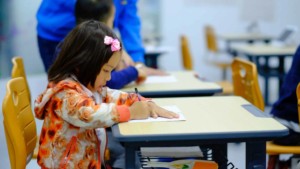5 Lessons Learned in the Transition to Blended Learning

The Time Really is Now
“If we simply wait for the future to become the present–that is, if we wait until new data about new ways to teach and learn arrive on the scene–data will continue to joust with other data, and little will change…The basis of action and change is theory, not data.” Clayton M. Christensen, Forward, Blended: Using Disruptive Innovation To Improve Schools by Michael B. Horn & Heather Staker
Seventy-five school district teams in Texas are not waiting for the future to simply happen. Using the theory of disruptive innovation (amongst others) as a lens through which to see the opportunities and challenges within their educational entities, these motivated teams took part in an immersive, two-day workshop series led by Heather Staker as part of the Raising Blended Learners Grant Initiative by Raise Your Hand Texas.
Raising Blended Learners
According to Raise Your Hand Texas, their vision is to “implement a demonstration initiative that showcases strategies for using blended learning to personalize instruction, thereby improving student achievement, particularly among schools and districts with persistent achievement gaps”
I had the pleasure of attending one of the workshop series in preparation for a supporting role I will be playing in the project. After working with several of the district teams for what, by my calculations, ended up being twenty hours over two days, I left feeling simultaneously exhausted and energized. Exhausted from all the thinking, learning, and reflecting and energized (with an appropriate level of cautious optimism) about all the possibilities for impact in our state. Here are a couple takeaways that stood out in regards to the experience, feedback from the district teams, and the pathway forward.
Blended Workshop Takeaways
1. Experiencing Blended as a Learner Matters: District teams engaged in blended learning in the role of learners themselves over the two days. Using a platform developed by Agilix, called Buzz, workshop participants completed pre-work prior to the session, explored their choice of content throughout activities, responded to discussion threads, took surveys and polls, and, at times, were given options about their preferred learning modality. For example individuals could decide if they wanted to watch Heather’s mini-lecture, “Is Blended Learning Disruptive?”, face-to-face in the middle of the room or watch a video of the same lecture independently in the round table sections around the room with the ability to pause, replay, or double time the pacing of the video. This online content was paired with plenty of meaningful face-to-face time working with their district teams, the facilitators, and other teams.
The key was we actually did it. We experienced what it feels like to choose your own learning modality, choose your own path, pace, and even place to learn. It was common to hear participants saying things like, “They are actually practicing what they preach,” and, “Oh, this is what it [blended] could look like.”
My Takeaway: Want to blend in your own district or campus? Make sure you have an opportunity to experience a blended environment as an authentic learner first. You will have fresh eyes and ideas with which to make good choices for students.
2. Learning Design & Attention to Detail Matters: Everything from the layout of the room and signage, to the transition music, pacing and opportunities for choice, were clearly intentional and well-designed. Everyone knew what to do and where to go because the expectations were set, shared, practiced, and refined as we built a mini learning culture. In the event a passionate conversation distracted us from our specific task, or logistical movement around the room, the section facilitators kindly checked in and kept us moving in the right direction.
I have never seen such a large group (over 100 in our sessions) moved from location to location and task to task with such precision and success.
My Takeaway: When designing blended learning opportunities all the details matter. How will students take out and put away their earphones? What will learners do if they run into a technical problem or see a peer off task? Many potential challenges with a shift to blended learning can be overcome before they happen by planning for and remaining consistent in our response, as educators, to these moments and specific routines.
Aspire Public Schools uses these 21 lessons to engrain procedures and expectations into the classroom culture before implementing the station rotation blended model in their K-5 classrooms.
3. A Sense of Urgency and Purpose Matters: One of my favorite parts of the Blended workshop was hearing teams fast-pitch the prototypes of their blended learning plans. Group after group shared the why behind their vision and the relevance of their SMART goals relating to their specific student population, community, and district needs. There was a tangible level of passion and sense of urgency around solving the heavy, complex problems faced. Several teams simply stated, “We have to change. What we are doing now is not working.” or “It is not good enough.” And they weren’t just talking about test scores, but also developing core dispositions and a joyful student experience. Full transparency flowed from leaders relating to the current state of affairs with no sugarcoating, yet optimism spread as teams took the first steps to prototype a plan of action.
My Takeaway: The ‘why’ behind your blended implementation must be your North Star. A shift to true blended learning will take commitment and grit. In those moments when your team is struggling, stalling, or divided, let your purpose (ideally something student-centered) bring you back together as you urgently seek positive change.
4. Teams Matter: Team organization and design was a major focus of the Blended workshop. Heather Staker led participants through an exploration of the distinctions between functional, lightweight, heavyweight, and autonomous teams and examples of when each type would be appropriate to implement.
To solidify the value of strategic collaboration, the district teams were given plenty of focused time to work together over the two days. It seemed there was a shared sentiment amongst the teams and facilitators regarding the value of simply being together for uninterrupted, focused time over two days.
My Takeaway: Selecting the right type of team to tackle specific problems will make all the difference as you implement blended learning. Take the time to develop the best team composition before heading down the path to change and prioritize regularly scheduled, focused time throughout the implementation to maintain open communication and work together towards your goals.
5. Theory Matters: The Blended workshop and book are built upon the backbone of theory and research. Heather Staker frequently referred to these theories and principles as lenses through which we could better understand, design, and implement blended learning. “Innovation doesn’t have to be a guessing game,” Heather Staker declared.
Applying business and innovation theory to explain the difference in opportunities to implement blended learning as a sustaining innovation, to improve upon what already exists or as a disruptive innovation, to provide for areas of non-consumption where student needs are not currently being met, helped participants apply the appropriate blended learning models and team to their prototypes.
My Takeaway: As education leaders, we’re all aware that we’re dealing with children’s lives and experimentation feels risky, but it is precisely in those risks we provide them with a better, brighter future. Grounded in solid theory, intentional planning, and continual self-assessment and iteration, we can confidently take the steps necessary to innovate from a place of knowledge, albeit not omniscience.
As I reflect and prepare for my role in the Raising Blended Learners Initiative going forward, which will involve supporting many of these districts in their implementation process, I will keep this hopeful prediction from Blended in the forefront of my mind alongside the reality of the mountain of work that stands before us to get to the fruit of this promise.
“As online learning helps students to know, schools should be able to focus increasingly on helping students to do and to be.”
7 Resources To Support Building a Better Blended
Interested in learning more about blended learning or this project? Check out the resources below and follow the hashtag #raisingblendedlearners.
- Blended: Using Disruptive Innovation to Improve Schools A field guide and framework to understand, mobilize, design, and implement blended learning, by Michael B. Horn & Heather Staker
- Blended Learning Universe: Comprehensive online hub for all things blended learning including a school directory of blended learning profiles.
- Blended Learning Implementation Guide 3.0: Resource guide for planning and implementing blended learning, by Getting Smart
- Improving Conditions & Careers: How Blended Learning Can Improve the Teaching Profession, Resource guide which outlines how blended learning environments can create better opportunities for teachers, by Getting Smart
- Digital Learning MOOCS: Massive Open Online Courses for Educators, by The Friday Institute
- Coaching Digital Learning: Cultivating a Culture of Change: This course is designed for those who “guide teachers’ integration of digital learning to directly enhance and support student learning”.
- Digital Learning Transition: Creating Future Ready Schools: This course is designed for leaders involved in planning and implementing digital learning initiatives.
- Relay Blended Learning Courses: Four, free, online modules of professional learning on blended learning topics, by the Relay Graduate School of Education
- Blended Learning Resource Library: A collection of white papers, case studies, and implementation guides on blended learning, by the Learning Accelerator.
For more blogs by Tracy Clark, check out:












0 Comments
Leave a Comment
Your email address will not be published. All fields are required.